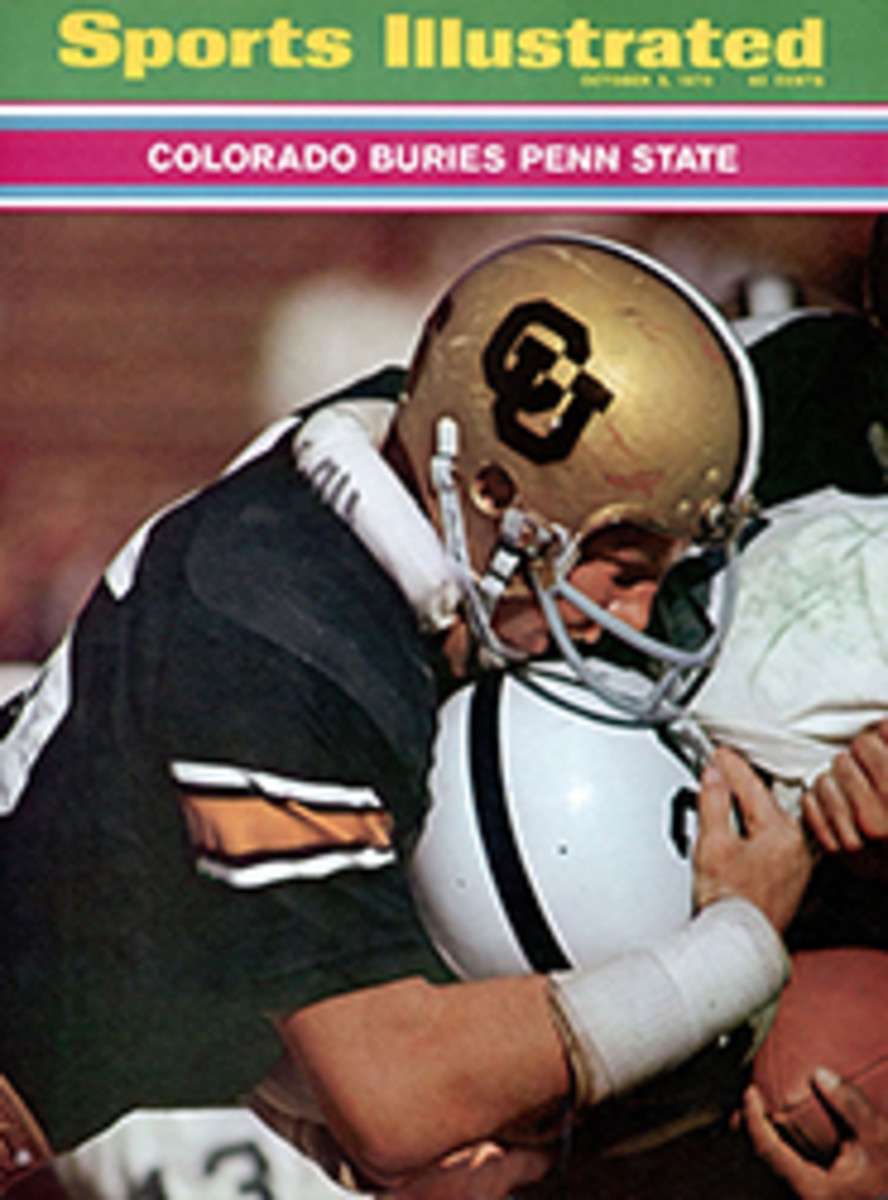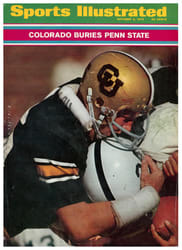
SCORECARD
BLOODY YANKS
Australians, never a notably placid people, turned flaming red and began spouting steam from their ears when their Gretel II was disqualified in that controversial second race of the America's Cup series. Americans, preoccupied with the pennant race in the National League East and the first games of the football season, may have wondered what the fuss was all about, but in Sydney and Melbourne and Brisbane and Adelaide and Perth the pubs were bouncing with ill-concealed fury. The Aussies disinterred, for conversational purposes, Les Darcy, the Australian wonder boxer who came to America to fight in 1917 and died in Tennessee, and Phar Lap, the Australian wonder horse who came to America to race in 1932 and died in California. The Sydney Daily Mirror asked, "When are the Americans going to stop nobbling our champions?" Another commentator wrote, "Everything the U.S. did for American-Australian good will in the Battle of the Coral Sea in 1942 was undone when the New York Yacht Club ruled out Australia's America's Cup win with a foul."
The Sydney Sun, more temperate, asked, "But what do we do? Send the [aircraft carrier] Melbourne? Withdraw from Vietnam? Confiscate the cost from General Motors' profits? Gretel won that race and gave Intrepid a shove start for good measure. But you can never beat the men who interpret the rule books."
When Gretel II came back to upset Intrepid, most Australian newspapers ran huge heads with just one word: GRETEL. And the Sydney Sun added in a most satisfying subhead: "Gretel's sweet revenge."
COLD COLORS
Charley Finley, owner of the Oakland Athletics, who pioneered green-and-gold uniforms and white shoes for his baseball players, suggested, after he had bought the National Hockey League's Oakland Seals, that he might put white skates on his hockey players. That suggestion was sternly rejected at the time by hockey authorities, but now, by golly, the staid old NHL has reversed itself. At least six of the 14 teams in the league will have brightly colored underpinnings this winter. The Detroit Red Wings will wear red skates, the Los Angeles Kings purple and gold, the Pittsburgh Penguins two-tone blue, the St. Louis Blues blue and gold and the Philadelphia Flyers orange and black. As for Charley Finley, never mind that placid white. His Seals expect to take the ice in the traditional Finley colors: kelly green and Fort Knox gold.
All right, now, what about those pucks? How about puce? Magenta? A lively psychedelic swirl?
BUCKS FOR THE BUCKS
Final returns on the Milwaukee Bucks' Lew Alcindor investment are in. The Wall Street Journal reports that for the fiscal year ending May 31, 1969—which means without Alcindor—Milwaukee Professional Sports & Services, Inc. reported a loss of $371,894. For the fiscal year ending May 31, 1970—with Alcindor—the Bucks reported a profit of more than half a million dollars. Before Looie, the Bucks were a last-place team with a record of 27 wins and 55 losses. With him, they won 56, lost 26 and made the NBA playoffs. Home attendance increased 50% to an average of 9,490 fans per game, and the Bucks had the best road attendance in the league. All this, and now Oscar Robertson, too.
RISING AND SETTING SUNS
Horse racing, very big in Japan, is apt to get even bigger or, at any rate, better. Japanese horsemen have been buying top bloodstock in Great Britain for the past few years and now have bought The Ridgewood Stud, one of the most modern stud farms in England. The aggressive Japanese have upset the British a bit, particularly in their purchase of Ridgewood. The previous owner, Mrs. Jennie Bolton, died a year ago at the age of 30, and proceeds of the sale are being held in trust for her 2-year-old son. The child's grandfather commented: "It is heartbreaking to see Ridgewood passing out of the family. The stud was bought by an agent on behalf of an unnamed client. I learned two days later that the client was Japanese. That came as a bit of a shock. Not that I have anything against them—but they do appear to be making plans to take us over."
KNOWLEDGE IS POWER
In its Adult Education Program this fall, Schreiber High School of Port Washington, N.Y. is offering a course called Football Togetherness which, according to the catalog, "is designed to help wives and mothers to survive the Fall football season. Whether you watch Little League, college or pro games, a knowledge of football basics can only add to your enjoyment of the crisp Fall air or smoke-filled TV room. Terminology (first down, defensive end, the difference between a block and a tackle) and fine points of play will be explained." Report to Room 10 Tuesday night, Oct. 6. Course costs $7.50 for five two-hour sessions. Pass it and maybe you can go on to more esoteric subjects like "Selected Pass Patterns" and "Advanced Blindside Blocking."
JOCK
Dr. Norman Hackerman, the new president of Rice University, is not a member of that group of educators who, either through personal distaste or practical economics, feel that college football is on the way out. He used to feel that way, he says, but not anymore. Dr. Hackerman, who was president of the University of Texas before moving to Rice, says, "Several years ago, because of the influx of professional football, I saw the end of intercollegiate football as we know it. But I have changed my mind. At Texas I learned that football is a good emotional focus. I like it. And I must point out that universities which have dropped football are now taking another look. I refer specifically to Fordham and the University of Chicago. Everything suggests that intercollegiate athletics is not vanishing from the scene.
"I don't have this totally academic idea," admits Dr. Hackerman, who at 58 plays squash twice a week and has a lean, agile athlete's build. "I may be criticized for being the other way."
HELLO, FISH
Mel Immergut, a Columbia Law School student, caught a 1,040-pound tuna last week in the Gulf of St. Lawrence oil' Canada's Prince Edward Island, breaking the unofficial record of 985 pounds set only 23 days earlier by Dr. Richard Hausknecht (SI, Sept. 21). Before Hausknecht and Immergut came along, the record had stood at 977 pounds for 20 years. Hausknecht had little trouble gelling the weight of his catch verified, for he was fishing off Montauk Point, which has a long history of record game fish. But Prince Edward Island is a place that has hardly been touched—until recently—by sports fishermen. Immergut chartered a weathered old lobster boat with a funny-looking barberlike fighting chair bolted to the deck. At 10 in the morning of the first day of fishing, after only 20 minutes of slow trolling, his bait was hit, and just 38 minutes later the big fish was brought alongside and gaffed. It was too large to fit through the landing door in the boat's transom and far too heavy to pull over the side, so they had to drag it ashore.
On shore, after using block and tackle to get the tuna into a borrowed truck, they drove to a platform scale at a nearby seaweed-processing plant. They weighed the truck with and without the fish, subtracting one figure from the other to get the tuna's weight. The man doing the weighing and subtracting kept muttering, "It couldn't be right." But it was: 1,040 pounds, the first thousand-pound tuna ever caught on rod and reel. Immergut began looking for more witnesses, but most of those he called were attending the funeral of a Prince Edward Island man who had died of a heart attack two days earlier after fighting a tuna for 45 minutes and then losing it. He also wanted verification from another scale. They hosed the fish down to slow dehydration and drove 12 miles to a fish-processing plant, but the scales there proved inadequate. They then took the fish for a two-hour drive to a fertilizer company. When they weighed it there, the tuna had shrunk to 1,030 pounds, but the record weight was verified.
The next day was too rough for fishing, but on the day after that John Kobayashi, Immergut's fishing companion, caught an 870-pounder, a tremendous tuna in its own right. Again, as they had so many times in the 48 hours since the morning the thousand-pounder had been caught, the two men spoke about a gift Immergut had given Kobayashi the night before they left for Prince Edward Island. It was a first edition of Zane Grey's Tales of Swordfish and Tuna, and inside the front cover Immergut had written an inscription, partly his, partly Hemingway's: "9-21-70. On the eve of the search for the great thousand-pound tuna—'In September, the month when the great fish come.' "
ODD COUPLE
And then there are Sam Rymer, who is 84, and his pal Mike Jones, 70 years younger, who landed a 42-pound, 12-ounce chinook salmon near Muskegon for a Michigan state record. The two not only weighed the monster, they carefully measured it, too—it was 42½" long, had a girth of 26" and a tail spread of 12", and its jaws opened to 7½". The only thing they didn't do was have it authenticated. Instead, they cut it into chunks, smoked it, ate some of it themselves and passed the remainder out to friends. Well, that's what a fish is for.
WOMEN'S LOB
Women tennis players have joined the revolution. Seven American and two Australian women decided to compete for prize money at the Virginia Slims tournament in Houston. The USLTA warned that if they played for money instead of trophies in that particular tournament they would be suspended. "We really don't care," said Billie Jean King, the top American player. The women were miffed because the next sanctioned tournament, the Pacific Coast International, had announced that the winner in men's singles would get $12,500, the winner in women's singles only $1,500. The Houston tournament withdrew its prize money but the women deliberately accepted token payments from World Tennis magazine, which, in effect, made them contract pros, and the tournament reinstated the cash. Then the Pacific Coast International announced that prize money in the women's division there had been upped from $2,000 to $11,000. "This is the greatest thing that ever happened to women's tennis," beamed Mrs. King. "In substance, the USLTA was asking us to take money under the table again. I've received $4,500 in expenses for competing in one tournament. Well, we've had enough of that.
"This is not a women's liberation movement," she added. "It's professional tennis. If you get money from a sport, you should be labeled a pro."
ILLUSTRATION
THEY SAID IT
•Scott Hunter, Alabama quarterback, on why he came to Alabama: "My folks went to Auburn. Joe Childress [former star running back at Auburn] was my cousin. My father's uncle coached at Georgia. And I used to live in Mississippi. That meant I had to go to Alabama. Right?"
•Duffy Daugherty, Michigan State football coach, on hearing the suggestion that State's 42-16 loss to Washington could be attributed to the lack of traction his teams' shoes had on the artificial turf: "Blaming shoes for our loss is like blaming the Johnstown flood on a leaky faucet in Altoona."
•Dr. Don Tarr, 31-year-old general practitioner from Miami, explaining why he races stock cars on NASCAR's Grand National circuit: "I race because I enjoy it. I could make three times as much money if I never paid attention to anything but my practice and delivered more babies. But what good is all that money?"
•Dit Clapper, Boston Bruins star for 20 years and member of hockey's Hall of Fame: "Bobby Orr is the greatest defenseman who ever lived. He's better than Eddie Shore or I ever was. He can do everything. He's worth every cent he gets."

